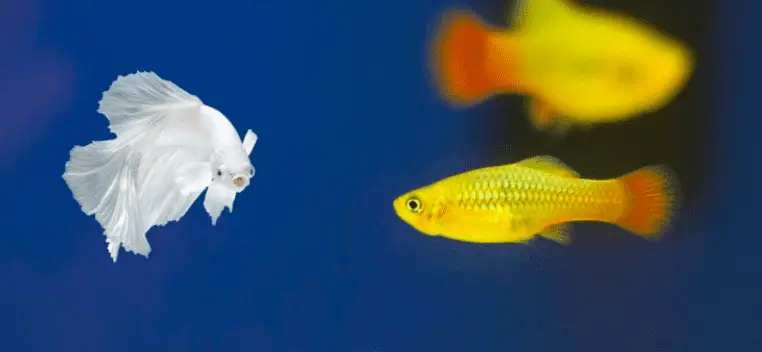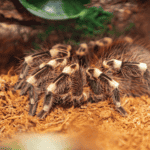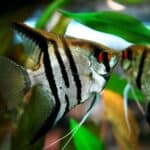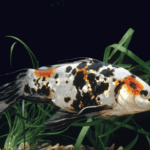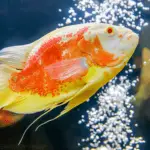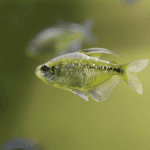If you’re like me, you probably love spending time watching your fish swim around in their tank. It’s especially fun to watch them interact with each other. But sometimes it can be tough to decide which fish to put together in a tank.
In this blog post, we will explore the question of whether Bettas and Platies can live together. Keep reading for more information on how to create a successful aquarium with these two types of fish.
Can Bettas And Platies Live Together?
Yes, bettas and platies can live together. They both originate from Southeast Asia and have similar requirements for water, food, and temperature.
However, it depends on the aggressive nature of your betta. If your betta is very aggressive, it’s best to keep him away from other fish. On the other hand, if your betta is relatively docile, he should be fine living with platies.
The important thing to remember is that you need to provide enough space for both types of fish. I recommend a tank that is at least 20-gallon if you plan on keeping both bettas and platies together.
You also need to make sure that the tank has plenty of hiding places for the fish. I suggest adding live plants, rocks, and driftwood to the tank. This will give the fish somewhere to hide if they feel threatened or stressed.
Another thing to keep in mind is that Bettas are known to be fin nippers. This means they may try to bite the fins of other fish. Platies have long fins, which makes them a prime target for Bettas.
The Gender Of Your Betta & Platies
The gender of your fish is also something to consider when deciding whether to put them together in the same tank.
Males species of bettas are the most aggressive and are more likely to nip at the fins of other fish. If you have a male betta, it’s best to keep him away from other fish.
Female bettas are less aggressive and can usually live peacefully with other fish. However, if you plan on breeding your fish, it’s best to keep them separate.
How Many Platies Can I Keep With My Bettas?
It depends on the size of your tank and how many fish you want to keep. Let’s explore the different possibilities:
How many platies can I put in a 5-gallon tank with a betta?
It’s not recommended to use a 5-gallon tank for any fish, let alone two different species. A better option would be a 20-gallon tank. This will give the fish enough space to swim and hide if they need to.
How many platies can I put in a 10-gallon tank with a betta?
A 10-gallon tank big enough for a few fish. So you could probably put two or three platies in a tank with a betta. Just make sure to provide plenty of hiding places and avoid putting males and females together if you don’t want babies.
How many platies can I put in a 20-gallon tank with a betta?
A 20-gallon tank is a good size for bettas and platies. You could probably put four or five platies in a tank with a betta. Just watch the fish closely to make sure they’re getting along and provide plenty of hiding places.
Will Betta Fish Eat Baby Platies?
Yes, betta fish will eat baby platies if they are small enough. Platies are livebearers, which means they give birth to live young. This means that baby platies are especially vulnerable to being eaten by other fish.
It’s not recommended to put bettas and platies together if you are planning on breeding either species of fish. This is because the bettas will likely eat the baby platies.
My Platies Are Eating My Bettas Food
One problem you might run into if you put bettas and platies together is that the platies will eat the bettas food. This is because platies are omnivores and will eat just about anything.
To solve this problem, you can feed at different times or in different areas of the tank. For example, you can provide the platies in one corner of the tank and the bettas in another corner. This will give each fish time to eat their own food without having to compete with the other fish.
How Do I Introduce My Betta to Platies?
If you’re planning on putting bettas and platies together, it’s important to introduce them properly. The best way to do this is to slowly and gradually add the platies to the tank.
Start by adding one or two platies and watch the fish closely for any signs of aggression. If everything goes well, you can add more platies to the tank. Just make sure to go slowly and keep an eye on the fish.
If you introduce the fish too quickly or put too many fish in the tank at once, it could cause stress and aggression. This is why it’s important to take your time and do it gradually.
Use a quarantine tank – Before you add any new fish to your tank, it’s a good idea to quarantine them first. This is because new fish can often carry diseases or parasites that can infect the other fish in your tank.
A quarantine tank is a separate tank where you can keep the new fish for a few weeks before adding them to your main tank. This will help to ensure that the new fish are healthy and won’t infect the other fish.
Can Platies Eat Betta Food?
Yes, platies can eat betta food. In fact, platies are omnivores and will eat just about anything. So if you’re planning on putting platies and bettas together, you’ll need to be sure to feed them separately.
While they can technically eat the same food, it’s not recommended. It’s a better idea to feed the platies their own food and the bettas their own food. This way, each fish will get the nutrition they need without having to compete with the other fish.
What Else Should I Consider?
When thinking about putting platies and bettas together, there are a few other things you should consider.
1) Cleaning
Platies are known for being messy eaters. This means that they will often leave behind uneaten food, which can pollute the water and cause problems for the other fish in the tank.
To solve this problem, you’ll need to be sure to clean the tank more often. This means doing things like changing the water more often and making sure the filter is working properly.
2) Decorations
When keeping platies and bettas together, it’s important to provide plenty of hiding places. This is because platies are known for being shy fish. They will often hide away if they feel stressed or threatened.
Providing plenty of hiding places will help to reduce stress and make the fish feel more comfortable. Hiding places can be things like caves, plants, or even pieces of driftwood.
3) Fighting
Bettas are known for being aggressive fish. This means that they may try to fight with the platies. So if you’re putting these two fish together, you’ll need to watch out for signs of aggression.
Some signs of aggression include chasing, biting, and nipping. If you see any of these behaviors, it’s best to separate the fish into different tanks.
Conclusion
In conclusion, it’s possible to put platies and bettas together. However, there are a few things you need to consider before doing so. These include the tank size, food, breed of fish, quarantine tank, and decorations.
If you take your time and do your research, you can successfully keep these two fish together. Just be sure to watch out for signs of aggression and be prepared to clean the tank more often.
I hope this has helped you to better understand whether or not platies and bettas can live together. If you have any further questions, please feel free to leave them in the comments below.
